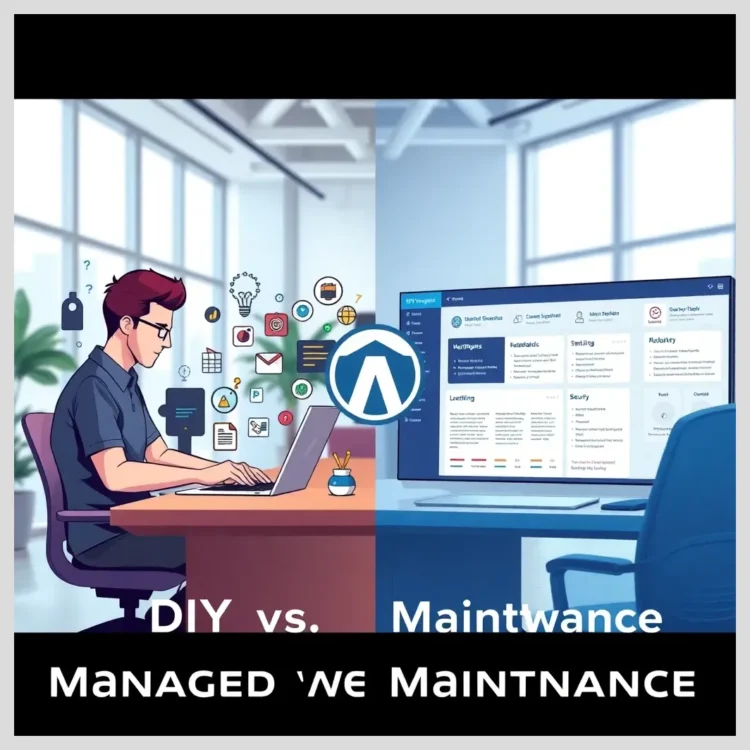In this article:
We will explore why website maintenance is crucial for WordPress sites, the hidden costs of skipping maintenance, and the core tasks included in most maintenance plans. We will also break down the factors that affect maintenance costs, compare different plan tiers, and discuss the pros and cons of DIY versus professional services. Additionally, we will review Modular DS, a leading solution for managing WordPress sites, and provide practical tips to maximize the value of your maintenance plan.
Key points covered in this guide include
- Understanding the risks of neglecting WordPress maintenance
- Core maintenance tasks like updates, backups, and security monitoring
- How website size, traffic, and complexity affect maintenance costs
- Comparing basic, intermediate, and advanced maintenance plans
- Pros and cons of DIY maintenance versus professional services
- An in-depth look at Modular DS as a WordPress site management tool
- How to evaluate and choose the best maintenance plan for your site
- Common mistakes to avoid and tips for maximizing plan value
Introduction: Why Choosing the Right WordPress Maintenance Plan Matters
Maintaining a WordPress website is not just about keeping it looking good; it’s about ensuring it runs securely, efficiently, and reliably. A well-maintained site protects your business from security breaches, prevents downtime that can cost you visitors and revenue, and keeps your site performing at its best. Choosing the right WordPress maintenance plan means entrusting your site’s health to a team or system that handles updates, backups, security checks, and support regularly.
Without a proper maintenance plan, your website becomes vulnerable to hackers, slow loading times, and compatibility issues that frustrate visitors and damage your reputation. This guide will walk you through everything you need to know to select a plan that fits your unique needs, whether you run a small blog or a busy e-commerce store.
Expect to learn about the essential maintenance tasks, how costs vary, and how to balance price with features and support. We’ll also introduce you to Modular DS, a powerful platform that automates and centralizes WordPress site management for agencies and professionals.

Choose wordpress maintenance plan
The Hidden Costs of Skipping a WordPress Maintenance Plan
Many website owners underestimate the risks of neglecting regular website maintenance. The consequences can be severe and costly.
Security vulnerabilities are the most alarming risk. Outdated WordPress core files, plugins, or themes can open doors for hackers to inject malware or steal data. Recovering from a hack often requires expensive cleanup and can damage your brand’s trust.
Downtime is another hidden cost. If your site crashes or is taken offline due to incompatibilities or attacks, you lose visitors and potential sales. Even short outages can hurt your SEO rankings and user confidence.
Performance degradation happens when your site isn’t optimized or updated. Slow loading pages frustrate users and increase bounce rates, directly impacting your search engine rankings and conversions.
Compatibility conflicts arise when plugins or themes don’t work well with the latest WordPress version or with each other. This can cause broken features or site errors that require technical fixes.
The risk of data loss looms large without reliable backups. A corrupted database or accidental deletion can wipe out your content, products, or customer information.
All these issues translate into financial losses, wasted time, and damaged reputation. Investing in a solid maintenance plan is a smart way to avoid these hidden costs.
WordPress Maintenance Costs: What You Need to Know
Maintenance costs vary widely depending on your site’s size, complexity, and specific needs. A small personal blog might only need basic updates and backups, while a large e-commerce site requires advanced security, performance tuning, and custom support.
Typical maintenance plans range from around $30 to over $500 per month. Lower-tier plans cover essential updates, backups, and basic security monitoring. Mid-tier plans add performance optimization, SEO checks, and content updates. Premium plans include custom development, staging environments, uptime guarantees, and priority support.
Choosing a reliable, affordable, and secure plan means balancing your budget with the features and support your website demands. This guide will help you understand what each plan level offers and how to pick the right one.
Core maintenance tasks include regular updates, security monitoring, backups, performance optimization, uptime monitoring, and technical support. Advanced services may cover content management, SEO maintenance, and compliance checks.
Core Tasks Included in Most WordPress Maintenance Plans
Regular WordPress Core, Plugin, and Theme Updates
Keeping WordPress core, plugins, and themes up to date is vital for security and compatibility. Updates patch vulnerabilities and add new features. Most experts recommend checking for updates at least weekly, though critical security updates should be applied immediately.
 WordPress Maintenance Plans for Agencies in the UK
WordPress Maintenance Plans for Agencies in the UKFailing to update can leave your site exposed to attacks or cause plugins to malfunction. A good maintenance plan automates or manages these updates safely, often testing compatibility before applying them.
Security Monitoring and Malware Removal
Security threats like brute force attacks, malware injections, and spam can cripple your site. Maintenance plans include continuous security monitoring to detect suspicious activity early. Malware scanning tools identify infections, and cleanup services remove malicious code.
Some plans also offer firewall integration and login protection to further harden your site’s defenses.
Reliable Website Backups
Backups are your safety net. They allow you to restore your site quickly if something goes wrong. Maintenance plans typically offer full backups, incremental backups, or cloud-based backups stored offsite.
Backup frequency varies but weekly or daily backups are common. Testing restoration processes ensures backups are usable when needed.
Performance Optimization
Speed matters. Maintenance services optimize your site by enabling caching, compressing images, minimizing code, and cleaning databases. These improvements reduce load times, enhance user experience, and boost SEO rankings.
Regular performance audits identify bottlenecks and recommend fixes.
Uptime Monitoring and Alerts
Uptime monitoring tools check your site’s availability around the clock. If downtime occurs, you receive alerts to act quickly. This proactive approach minimizes lost visitors and revenue.
Technical Support and Troubleshooting
Professional maintenance plans provide access to expert support via tickets, chat, or phone. Timely assistance resolves issues before they escalate, ensuring your site stays healthy and functional.

Choose wordpress maintenance plan
Factors That Affect the Cost and Choice of WordPress Maintenance Plans
Website Size and Complexity
Small blogs with few pages and plugins require less maintenance than large, complex sites with custom features. More pages and functionalities mean more updates, testing, and monitoring.
Traffic Volume and User Demands
High-traffic sites need robust performance optimization and uptime monitoring to handle visitor loads without slowing down or crashing.
Number and Type of Plugins and Themes
Sites with many plugins or custom themes face higher maintenance complexity. Each plugin adds potential compatibility issues and security risks.
Custom Features and Integrations
Custom-coded features or integrations with third-party services require specialized maintenance and testing to ensure ongoing compatibility.
Content Update Frequency and SEO Needs
Sites that regularly publish new content or require SEO optimization benefit from plans that include content management and SEO audits.
Hosting Environment and Geographic Distribution
Managed hosting often includes some maintenance services, reducing external costs. Sites serving global audiences may need CDN integration and monitoring across regions.
Compliance Requirements (e.g., GDPR, PCI)
Industries with regulatory requirements need extra security monitoring and documentation, increasing maintenance complexity and cost.
Comparing WordPress Maintenance Plans: Basic, Intermediate, and Advanced Packages
Basic Plans ($30–$75/month)
- Core WordPress, plugin, and theme updates
- Regular backups with restoration testing
- Basic security monitoring and malware scans
- Suitable for personal blogs and small business sites
Intermediate Plans ($75–$150/month)
- All basic services plus enhanced security features
- Performance optimization and caching
- SEO checks and content updates
- More frequent backups and uptime monitoring
- Ideal for growing businesses and professional blogs
Advanced or Premium Plans ($150–$500+/month)
- Custom development and integration support
- Priority technical support and staging environments
- Comprehensive uptime guarantees and monitoring
- Advanced security audits and compliance checks
- Best for e-commerce, high-traffic, or mission-critical sites
Comparison of WordPress Maintenance Plans and Modular DS Features
$30–$75/mo
$75–$150/mo
$150–$500+/mo
Modular DS vs Competitors Feature Comparison
| Feature | Modular DS | Competitor A | Competitor B |
|---|---|---|---|
| Multi-site Management | Yes | Limited | Yes |
| Automated Updates | Yes | Partial | Yes |
| Security Monitoring | Comprehensive | Basic | Moderate |
| Backup Solutions | Cloud backups + restore testing | Manual | Cloud backups |
| Performance Optimization | Included | Add-on | Included |
| Client Reporting | Detailed, automated | Manual | Limited |
| Pricing | Competitive, scalable | Higher | Lower but limited features |
DIY WordPress Maintenance vs. Professional Maintenance Services
Pros of DIY Maintenance
- Cost savings by handling tasks yourself
- Full control over updates and backups
- Learning opportunity to understand your site better
Cons of DIY Maintenance
- Time-consuming and requires technical skills
- Risk of errors causing downtime or data loss
- Difficulty staying on top of security threats and updates
Benefits of Hiring Professional Maintenance Services
- Expertise and experience managing WordPress sites
- Time savings allowing you to focus on your business
- Reliable security monitoring and quick issue resolution
- Regular updates and performance optimization
- Access to advanced tools and support channels
Cost Comparison and Value Analysis
While DIY maintenance saves money upfront, professional services often prevent costly mistakes and downtime. For busy site owners, outsourcing maintenance is a worthwhile investment.
Modular DS: A Leading Solution for WordPress Site Management and Maintenance
Description of Modular DS
Modular DS is a centralized automation and management platform designed for agencies and professionals managing multiple WordPress sites. It simplifies WordPress site management by automating updates, backups, security scans, performance monitoring, and client reporting.
The platform supports multi-site management, allowing users to oversee all their WordPress websites from one dashboard. It offers customizable workflows and detailed analytics to streamline maintenance tasks efficiently.
Pricing Overview
Modular DS offers transparent, scalable pricing tiers tailored to agencies and freelancers. Plans start affordably and grow with your portfolio, providing excellent value for the features included.
Comparison Table: Modular DS vs. Other Popular WordPress Maintenance Tools
| Feature | Modular DS | Competitor A | Competitor B |
|---|---|---|---|
| Multi-site Management | Yes | Limited | Yes |
| Automated Updates | Yes | Partial | Yes |
| Security Monitoring | Comprehensive | Basic | Moderate |
| Backup Solutions | Cloud backups + restore testing | Manual | Cloud backups |
| Performance Optimization | Included | Add-on | Included |
| Client Reporting | Detailed, automated | Manual | Limited |
| Pricing | Competitive, scalable | Higher | Lower but limited features |
Pros and Cons of Modular DS
- Pros Reliable, efficient, user-friendly, customizable, professional support, multi-site automation, detailed reporting
- Cons Pricing may be higher for very small users, some learning curve for new users
Customer Testimonials and Case Studies
“Modular DS has transformed how we manage dozens of client sites. The automation saves us hours every week, and the security monitoring gives us peace of mind.” – Agency Owner
“Thanks to Modular DS, our site uptime has improved dramatically, and clients appreciate the detailed reports we provide.” – Freelance Developer
Real success stories from Modular DS Case Studies highlight measurable improvements in efficiency, security, and client satisfaction.
If you manage multiple WordPress sites and want to streamline maintenance with a professional, reliable tool, consider trying Modular DS . Automate updates, backups, security, and reporting all in one place. Get started today and take control of your WordPress site management!
How to Evaluate and Choose the Best WordPress Maintenance Plan for Your Site
Start by assessing your website’s size, traffic, and complexity. A small blog needs different support than a busy e-commerce store. Define your priorities around security, uptime, and performance.
Consider your budget and whether you prefer to handle some maintenance yourself or outsource completely. Look for plans with transparent pricing and clear service descriptions.
Check provider reliability by reading testimonials and reviews. Ensure they offer timely, professional support through your preferred channels.
Look for additional services like SEO maintenance, content updates, and hosting support if those are important to your business.
Choosing the right plan is about balancing cost, features, and peace of mind.
Common Mistakes to Avoid When Selecting a WordPress Maintenance Plan
Avoid choosing the cheapest plan without understanding what’s included. Some low-cost plans lack essential security or backup features.
Don’t overlook performance optimization—it’s key to user experience and SEO.
Always verify the provider’s reputation and responsiveness. Poor support can leave you stranded during critical issues.
Read the fine print on cancellation policies and service level agreements (SLA) to avoid surprises.
Benefits
Benefits
Enhances website security by regular updates and monitoring to prevent hacks and malware.
Reduces downtime and improves uptime with proactive monitoring and alerts.
Optimizes performance through caching, image compression, and database cleaning, boosting SEO and user experience.
Provides reliable backups and restoration options to prevent data loss.
Offers expert technical support and troubleshooting to quickly resolve issues.
Risks
Security vulnerabilities from outdated WordPress core, plugins, or themes leading to hacks and malware infections.
Website downtime causing loss of visitors, revenue, and SEO ranking drops.
Performance degradation resulting in slow loading times and higher bounce rates.
Compatibility conflicts between plugins, themes, and WordPress versions causing errors or broken features.
Risk of data loss without reliable backups, leading to potential content or customer information loss.
Tips for Maximizing the Value of Your WordPress Maintenance Plan
- Schedule regular performance and security audits to catch issues early
- Keep open communication with your maintenance provider for quick problem resolution
- Use automated reports to monitor your site’s health and progress
- Combine maintenance with SEO and content updates for best results
- Review and adjust your plan regularly as your site grows and changes
Real Opinions and Experiences from WordPress Site Owners and Professionals
Small business owners often praise maintenance plans for saving time and preventing headaches. Freelance developers appreciate tools like Modular DS for managing multiple clients efficiently.
Digital marketers highlight the importance of performance optimization and SEO maintenance included in intermediate and advanced plans.
Agencies report improved client trust and recurring revenue by offering comprehensive maintenance packages.
Common complaints include lack of transparency in pricing and slow support response times from some providers.
Summary: Key Takeaways for Choosing a WordPress Maintenance Plan
Regular WordPress maintenance is essential for security, performance, and peace of mind. Neglecting it risks costly downtime, hacks, and lost revenue.
Understand your site’s unique needs and budget to select a plan that balances cost with features and support.
Professional services and tools like Modular DS provide expertise, automation, and reliable support that DIY approaches often lack.
Proactive upkeep keeps your site fast, secure, and competitive in a fast-paced digital market.
References and Further Reading
- Modular DS Features
- Modular DS Case Studies
- Modular DS Pricing
- WP Engine WordPress Maintenance Plans
- White Label Agency WordPress Maintenance Guide
- FixRunner WordPress Maintenance Plans
- CMS Minds WordPress Maintenance Cost Guide
- WebyKing Guide to Selecting WordPress Maintenance Service
- Maintenance WP WordPress Maintenance Services
Frequently Asked Questions About Choosing a WordPress Maintenance Plan
What is included in a typical WordPress maintenance plan?
Most plans include regular WordPress core, plugin, and theme updates, security monitoring, malware removal, reliable backups, performance optimization, uptime monitoring, and technical support.
How often should I update WordPress core, plugins, and themes?
It’s best to check for updates weekly and apply critical security updates immediately to keep your site secure and compatible.
Can I manage WordPress maintenance myself or should I hire a professional?
You can manage basic maintenance yourself if you have the time and technical skills, but professional services offer expertise, save time, and reduce risks of errors and downtime.
How do I know if my website needs an advanced maintenance plan?
If your site has high traffic, e-commerce features, custom integrations, or strict uptime and security requirements, an advanced plan is recommended.
What are the signs of poor website maintenance?
Signs include frequent downtime, slow loading speeds, security warnings, outdated plugins, broken features, and lack of recent backups.
How does Modular DS simplify WordPress site management?
Modular DS centralizes management of multiple WordPress sites, automates updates, backups, security scans, and performance monitoring, and provides detailed client reporting.
What should I look for in a reliable WordPress maintenance service?
Look for transparent pricing, comprehensive service coverage, timely support, positive reviews, and additional features like SEO maintenance and content updates.
Have questions or thoughts about choosing a WordPress maintenance plan? What do you think about the importance of regular updates? How would you like your maintenance service to support your business? Share your opinions or ask anything in the comments below!


















